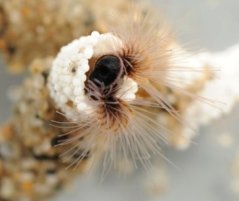Project
Sticky when wet: bioinspired underwater adhesives from telechelic block-copolymers (MSc Ilse van Hees)
Wet adhesion remains a challenging task to humans, while nature has already found an answer to this problem. Sandcastle worms build a protective shell from sand grains or pieces of shell found in their surroundings, by gluing them together using an adhesive protein. Research has revealed that these adhesive proteins contain large amounts of charged and hydrophobic amino acids. In this research, we synthesize ABA triblock copolymers containing a charged middle block, flanked by temperature sensitive outer blocks. The polymers are synthesized using the controlled polymerization method reversible addition chain transfer (RAFT) polymerization. Polymers synthesized using RAFT display narrow polydispersities and well defined block lengths, which simplifies analysis and comparison of the underwater glues.

Adhesives are made from mixing solutions, containing either anionic or cationic block copolymers. Upon mixing, the oppositely charged blocks form water insoluble complex coacervates. Complex coacervates display a low surface tension, enabling easy wetting of the surface, ensuring an optimum contact area. However, a glue also needs to set or harden, which is obtained by introducing the temperature sensitive outer blocks. At room temperature, these outer blocks are water soluble, while at elevated temperature the blocks become water insoluble. Consequently, elevated temperatures result in the formation of small domains in the complex coacervate, forming cross-links that strengthen the adhesive.
Part of this research is the synthesis of the polymers and the characterization of the adhesives using different scattering techniques, rheology, and adhesion measurements. The influence of different block lengths or block length ratios, the salt concentration, and temperature, on the adhesive strength are investigated. Furthermore, the salt and temperature dependent assembly of polymers in a dilute solution was studied.